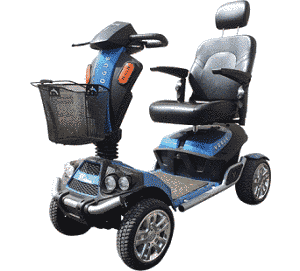INVALID CARRIAGES: UK road laws refer to powered wheelchairs and mobility scooters as invalid carriages.
This is according to their design and capabilities as per the road traffic act 1988 in the United Kingdom. The three types of mobility vehicles are:
- Class 1: Self or attendant propelled wheelchair (not powered by electric).
- Class 2: Mobility scooters and powered wheelchairs for use on footpaths or pavements (max speed limit 4 mph).
- Class 3: Mobility scooters and powered wheelchairs for use on the road (max speed limit 8 mph with a facility to travel at 4 mph on pavements).
We refer to the Use of Invalid Carriages on Highways Regulations 1988 (UICHR). They govern the use of powered wheelchairs and mobility scooters on public highways.
Rule 36: There is only one classification for manual wheelchairs. The road laws called a manual wheelchair a ‘Class 1 invalid carriage‘.
As a rule, you should only use a Class 1 invalid carriage on the footpath or pavements. But, there are two classes of powered wheelchairs and powered mobility scooters.
Class 2 vehicles (including wheelchairs) are those with an upper speed limit of 4 mph (6 km/h). Their design and capability is for use on pavements.
Vehicles with an upper speed limit of 8 mph (12 km/h) are Class 3 invalid carriages. Their design and equipment means they can get used on some roads as well as the pavements.
Rule 37: Users should obey the rules and guidance for road vehicles when using invalid carriages and associated devices on the road. You should also follow the regulations for pedestrians while using the pavement.
Using Invalid Carriages on Pavements
Rule 38: Using manual and powered wheelchairs on the pavement is safer than on the road. Even so, you should give priority to other pedestrians using footpaths and pavements.
Rule 39: Powered wheelchairs and scooters MUST NOT travel faster than 4 mph (6 km/h) on pavements or in pedestrian areas. Thus, reduce your speed in congested areas and on narrow pathways.
Rule 40: Always try to use pavement dropped curbs. Look around for dangers before joining the roadway in a safe manner.
Approach and climb high kerb stones at right angles. Avoid crossing curbs higher than the manufacturer’s recommendations for your type of vehicle.
Note: Use heightened consideration and awareness to pavement users who may have a visual or oral impairment.

Using Invalid Carriages on the Road
Rule 41: Using a powered wheelchair or a mobility scooter on the road requires extra caution. Your vehicle is likely to be less visible to other traffic.
Your machine has a restriction of 8 mph (12 km/h) while traveling. Thus, according to all Highway Code rules, other traffic will be moving much faster than your vehicle.
Rule 42: Class 3 vehicles should travel in the same direction as the traffic when used on the road. But, Class 2 mobility scooter users should drive on the pavement when it is available. Use extra caution on the road if there is no pathway to use.
Wherever possible, users of a Class 2 invalid carriage should travel with the direction of the traffic. Users MUST use lights if you are travel at night. Thus, travel in the direction of the traffic at night to avoid confusing other road users.
Rule 43: You Must follow the same road rules as other road users. This applies to lights, horns, and indicators (if fitted).
Wear a reflective jacket for added visibility at night time or dusk. Consider fitting reflective strips to the rear of your mobility scooter or invalid carriage.
Rule 44: Always use extra caution at road junctions when going straight ahead. Check there are no vehicles about to cross your path from the left or right. They may also be overtaking you to turn left in front of you.
- Make a stop on the left-hand side of the road and then wait for a safe gap in the traffic.
- Negotiate the turn in the same way as a pedestrian would. Travel along the footpath and then cross the road between pavements where it is safe to do so. In this case, users of a Class 3 invalid carriage should switch the machine to the low speed limit while on pavements.
Several options are available when dealing with right turns (e.g. from a major road). You may find it difficult to move into the middle of the road. Thus, you can either:
You might consider using an alternative route if there are hazardous junctions. Similar rules apply when negotiating major roundabouts (two or more lanes). It could be safer to use the pavement or to find a route avoiding the roundabout altogether.
Rule 45: Invalid carriages should not create a pedestrian obstruction when left unattended. Thus, the rules for mobility scooter users highlight the observance of all regulated parking restrictions.
Note: Parking concessions apply for those displaying valid Blue Badge parking permits.
Rule 46: You MUST NOT use invalid carriages on motorways or on smart motorways. They should not get used on unrestricted dual carriageways (more than 50 mph).
We refer to the Road Vehicle Lighting Regulations (RVLR). Invalid carriages MUST have a flashing amber beacon when used on unrestricted carriageways. You should use the amber beacon on any other dual carriageway.
Note: The Government plans to scrap EU ‘Vnuk’ motor insurance law (e.g. requiring insurance for a wide range of vehicles such as quad bikes, mobility scooters, and ride-on lawnmowers).

